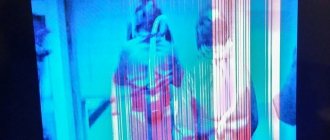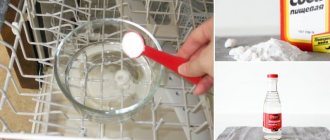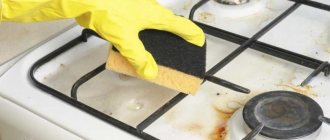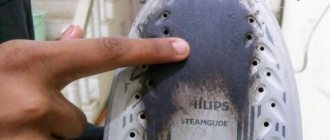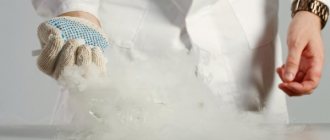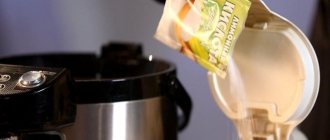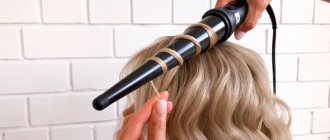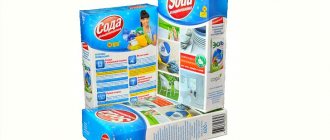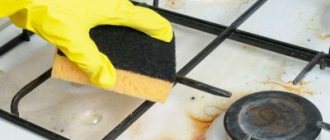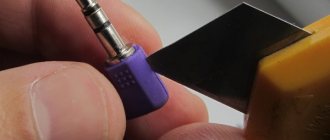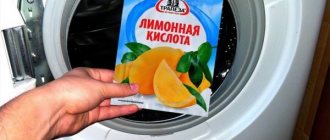Content:
- 1 Features of LCD monitors
- 2 Reasons for screen contamination
- 3 How not to clean
- 4 How to properly care for your TV
- 5 Fabric selection
- 6 Specifics of using special napkins
- TOP 7 professional LED TV care products
- 8 General rules for cleaning LCD TVs
- 9 Frequency of care for different LED surfaces
LCD TVs are in demand due to the quality of the transmitted image. However, such screens are difficult to maintain. They cannot be washed with plain water or wet wipes. For delicate care, it is necessary to use special soft fabrics and cleaning sprays that do not contain alcohol, aggressive or abrasive particles. We will discuss in more detail how to wash the LCD TV screen in the article.
Safety rules for cleaning LCD screens
Rules:
- Before carrying out the manipulation, disconnect the monitor from the power supply. Next, you need to wipe the LCD TV screen using a dry microfiber cloth to remove dust and small particles. You can use substances that are designed for cleaning such products.
- Do not press on the surface, or scrape or scratch with your nails. It can be damaged by such influences. Under no circumstances should sprays or liquids be applied directly to the plasma.
- You should spray a lint-free microfiber cloth with the solution, only then clean it. The product should not drip from the napkin. It should not be wet, but slightly important. Only after the surface has completely dried can you turn on the electrical appliance.
- In addition to cleaning the screen itself, it is necessary to clean the case. To do this, use a mild cleanser. The screen must be cleaned once every 3 weeks to avoid dust accumulation.
- Do not use aggressive solvents. Liquids based on acids and alkalis are strictly unsuitable. They destroy the coating, which can cause failure.
Cleaning the monitor
Features of LCD monitors
LCD or LED displays have panels and cells that contain special liquid substances that have optical properties. Their molecules, under the influence of electromagnetic radiation, change orientation, affecting the polarization of the light beam.
Liquid seals are located between two glass panels. On the inside of the TV there are lamps that emit light and color filters. When the device is turned on, the matrix receives a signal from the reader (decoder) and distributes the position of the light, crystals, and color filters. As a result, a person sees a clear picture with high brightness and contrast.
The main characteristics of the LCD screen include:
- Monitor format. The old aspect ratio is 4 to 3. Modern versions work in the HD 16:9 standard.
- Resolution affects the clarity and detail of the image. It is optimal to choose models with Full HD.
- Diagonal. The optimal figure is 20-22 inches.
- Contrast and brightness affect the final color rendering.
- Response time is the minimum amount of time required for a pixel to change brightness. In simple words, the speed of image display.
It is also necessary to take into account the type of matrix, the number and types of connectors, and the presence of additional functions.
All TVs with LCD matrices are very sensitive to moisture, dust and temperature changes. Therefore, care requires careful, careful handling of the display.
Reasons for screen contamination
Home operating conditions for household appliances are far from ideal. Even the biggest cleaners still have a small amount of dust in the air. When sweeping or vacuuming, microparticles of dirt rise up. And they settle on household appliances. This becomes the first reason for the appearance of dark spots on the LCD screen.
Other reasons for the appearance of dark spots or other dirt include:
- Fingerprints, palm prints from even minor touches. Most often in a house with children, to whom it is difficult to explain that they should not play around with digital technology.
- Splashes that appear when trying to wipe the monitor with a heavily dampened cloth or when liquid accidentally gets on the surface.
Even if no one touched the TV and no liquid got on it, it’s worth knowing how to clean the TV screen at home. With proper care, the service life of the equipment increases significantly.
Proper cleaning of the TV screen
To properly clean your screen at home, simply follow the recommendations below:
- Turn off the device in advance to avoid problems such as short circuits. The TV should cool down well.
- Wet wipes are best for cleaning matte screens, while completely dry methods are best for glossy screens.
- Please remove all your jewelry to avoid possible damage to the display device.
- Do not allow moisture to get under the body of the device, and apply the cleaning agent exclusively to the rag itself.
- There should not be too much moisture on the cleaning material. You need to wring it out thoroughly and only then wipe the display.
- For cleaning, it is better to use high-quality lint-free material.
- To avoid any streaks, work from one end of the display to the other.
- Use a toothpick to reach various recesses and corners.
- If the mud stain has already dried, just carefully moisten it with a fairly damp cloth, soak it well and wipe it off.
Frequent TV breakdowns:
What to do if there is no picture on the LG TV but there is sound?
How to remove dead pixels from a monitor or TV at home?
How not to clean
The rules for handling a liquid crystal monitor do not depend on the brand and year of manufacture of the TV. Before you figure out what you can use to wipe the TV screen, remember what not to do.
Prohibitions include:
- Do not perform any manipulations with the equipment turned on. The matrix of an LCD monitor is very fragile; a slight surge in electricity can easily damage it.
- After cleaning the surface, do not immediately turn on the TV. You must wait until it dries completely so as not to damage the matrix.
- Products containing alcohol and cleaning products are prohibited. After using them, white streaks or spots will appear.
- Wet wipes used for household purposes are not allowed to be used for cleaning monitors. They contain components that are harmful to liquid crystals.
- Automotive cosmetics are intended for cars. It is not used for delicate cleaning of the TV surface. Detergents and window cleaning options are also not suitable.
- The newspaper is the enemy of any modern TV. It not only does not remove dirt, but also creates microcracks that gradually destroy the integrity of the protective glass.
- Direct spraying of cleaning products onto the screen will result in streaks and stains. Spray fibers instantly penetrate the structure and damage the matrix.
- Baking soda is good for cleaning grease stains from the stove and dishes. But it is prohibited for such delicate surfaces as plasma panels and LCD TVs.
- Try to wipe off dirt with a knife or other sharp object. Of course, this is the fastest way to remove large areas of dirt. But it leads to mechanical damage to the protective layer.
Important! The appearance of streaks on the monitor is the result of using wet wipes. Such a defect not only spoils the perception and clarity of the picture, but is also very difficult to remove from the surface.
Want to extend the life of your digital home technology? Use approved LED screen cleaning methods.
How to properly take care of TV
You can clean your TV monitor:
- Use a vacuum cleaner at minimum power, away from the screen. It is prohibited to bring the device very close.
- Use a rubber blower to suck up the dust. At the same time, you should also not come into contact with the monitor.
- A special broom with soft bristles. They can be purchased at household chemical or home improvement stores.
- Clean the surface with a lint-free cloth with minimal effort. That is, it is unacceptable to press the cloth too hard. Otherwise, due to mechanical damage, dark or white spots will appear when watching films.
The purpose of cleaning is to remove dust from the surface so that it does not accumulate and form black spots. Under the influence of electromagnetic waves, microparticles of dirt can be “absorbed” into the matrix and harm it. It is recommended to wipe the surface 2-3 times a week.
When cleaning is required
Before you figure out how to wipe the LED and LCD TV screen, you need to understand in what cases it is needed.
- Due to static electricity, the surface attracts dust, so there may be even more dust on a vertical surface than on a horizontal table.
- On a TV, especially a large plasma one, traces of insects can constantly be found as they cut into the screen.
- If there are children in the house, then fingerprints cannot be avoided.
- If you did wet cleaning incorrectly, streaks may remain.
All these contaminants do not add brightness to the image and increase eye strain.
There is no need to carry out a global cleaning with heavy chemicals every time a speck of dust appears on the screen. As they become dirty, carefully remove stains and, as a preventative measure, clean them once a week so that dirt does not accumulate and then you do not have to get rid of it using complicated methods.
Fabric selection
The best material to clean your LCD TV screen is soft cotton wipes. They will easily remove dust and will not harm the device. The use of microfiber and cotton material is also allowed.
When choosing a cleaning method, it is important to remember that LED monitors are very sensitive to the effects of any aggressive environment. Therefore, the best cleaning materials are:
- Special wipes for cleaning LCD displays. They can be purchased at computer and household appliance stores.
- Antistatic kits, which include dry wipes that absorb residual liquid and wet options with a special alcohol-free composition.
- Soft, lint-free fabrics. These include cotton, fleece and flannel. You can easily find them in any textile store. Moreover, you can immediately purchase a meter of material and cut it into the required pieces. This will give you the best cost-effective way to care for your TV.
- Microfiber and special napkins made from it perfectly absorb moisture. This material is worth having at home in case water unexpectedly gets on the screen.
- LED display care kits. The kit includes an aerosol without alcohol and aggressive components. As well as a microfiber cloth, an antistatic brush and additional attachments, accessories for cleaning hard-to-reach places and small crevices in equipment.
Important! Before wiping the LCD TV screen with a cloth moistened with a special product, you must wait until the material absorbs moisture. Only when the liquid is evenly distributed throughout the material can you begin cleaning.
What cloth to clean your TV with?
- Wet wipes specifically for cleaning TV screens, laptops, monitors and others. Does not contain alcohol.
- Antistatic kits, which include two types of rags - dry and wet. The first ones are made of dense microfiber and are needed to absorb the remaining liquid. Wet ones are used for dirt, grease stains and others. Due to the antistatic properties, dust adhesion is reduced after surface treatment.
- Lint-free delicate fabrics. Sold in textile stores. You can stock up for a long time. Buy a large piece of fabric, cut it into small pieces and put it in a bag to prevent accidental dusting. Representatives: fleece, cotton, flannel.
- Microfiber. Fabric with ultra-fine fibers that reach the most difficult places and absorb moisture and dust. There are microfiber cloths for sale for screens and optics. Effective against fingerprints. It's a good idea to have a microfiber cloth at home to remove any water or other liquid you accidentally touch.
- Comprehensive TV care kits. Includes spray liquid, antistatic brush, microfiber cloth. The kit additionally includes devices for cleaning difficult places (corners of the screen, crevices between buttons, etc.).
Specifics of using special napkins
Wondering how to remove stains from an LCD TV? You can purchase special cleaning products that are sold at hardware or computer accessories stores. However, when choosing them, one must take into account their features and the specifics of surface treatment.
| Napkin option | Peculiarities | Application procedure |
| Moisturized | Impregnated with a special composition without alcohol. Sold in computer stores. There are no abrasive particles in the composition. Dust and dirt are removed instantly. | Open a pack of tissues. Take one out and wipe the surface. Wait 1-2 minutes. And wipe another one with a napkin. The electrical appliance must be turned off. You can turn on the equipment 5-10 minutes after treatment. |
| Lint-free | They cope with dust, but not with heavy dirt. They won't erase stains. | Open the package, take out the napkin. Gently wipe the display. Do not press on the surface. Try to move with minimal amplitude. |
| Microfiber | A universal option for household appliances. Helps remove smudges and fingerprints. You can lightly moisten it with water, but wait until it is absorbed into the material. | Unpack the package. Wipe the display with a cloth. Don't press it too hard. Wait until it dries completely and turn on the equipment. |
Of all the options, microfiber can handle the toughest stains. You can buy it at hardware stores. Lint-free material removes dust and is needed for daily care.
TOP 7 professional LED TV care products
You can clean your LCD TV screen at home using professional products. These are sprays without alcohol or abrasive microparticles. Manufacturers took into account the peculiarities of LED displays during development, so they are safe for TV provided the rules for spraying the compositions are followed.
Among the tested options are:
- Colorway 3333 – compressed air in cans. The jet comes out under pressure through a special tube. The product can be used to blow out hard-to-reach places in the TV.
- Patron F3-029. A special foam that is applied first to a napkin and then to the screen.
- Colorway 1032 spray with antistatic coating for monitors. The formula removes surface contaminants and protects against dust adhesion.
- Data Flash 1620 liquid for delicate surfaces in the form of a spray. Gently cares for liquid crystal technology.
- Patron F4-001 for heavily soiled monitors. These are napkins made of crepe paper, which is not impregnated with alcohol, but effectively removes dirt from the surface.
- Colorway 1071 cleaning wipes for heavy soiling.
- Colorway 6108 – microfiber cloths based on silicone. The technology is based on a fine weave of fibers for the most delicate care.
The entire line of listed products is suitable not only for cleaning TVs, but also for treating smartphones, laptops, and computer monitors.
How to wipe the LCD TV screen?
Experts note what would be better for wiping a modern LCD TV if dust has accumulated on it. Allowed to use:
- blowing off with a vacuum cleaner or rubber bulb without touching the screen;
- panicle with long soft hairs;
- lint-free fabrics.
Narrowly directed air flows remove dust without harming the monitor.
What cloth is best to wipe the screen?
The surfaces of liquid crystal models are made as several very thin layers . They are sensitive to aggressive products, so it is important to know what cloth to use to wipe the screen of a dirty LCD TV . Allowed to use:
- wet wipes for cleaning displays, impregnated with special compounds without alcohol;
- slightly dried napkins that do not leave marks;
- antistatic kits - the kit includes dry (absorbs residual liquid) and wet (removes all contaminants) wipes;
- soft lint-free fabrics - cotton, flannel, fleece;
- microfiber cloths that absorb moisture well and do not leave scuffs and scratches on the surface;
- care kits - they include a special aerosol, a microfiber cloth, an antistatic brush, additional attachments and accessories.
Microfiber cloths work great
Important! The napkin is saturated with the product, and only then can the dirt be treated.
Professional products
Products intended for cleaning LCD monitors are available in the form of sprays, air cleaners, foam aerosols, and wipes impregnated with a special composition. You can purchase in online and offline stores:
- Colorway 3333. Compressed air in cans. A jet under pressure is released through a special air tube, which removes dirt and dust. The product is also used to purify hard-to-reach areas of the TV;
- Patron F3-029. Foam for TV screens, which delicately and streak-free cleans the liquid crystal surface from dust, dirt, stains, and fingerprints;
- Colorway 1032. Spray that creates an antistatic coating on the monitor. The product formula helps to effectively remove stains and dirt without harming the surface;
- Data Flash 1620. Spray for delicate surfaces that gently removes dirt from the LCD display;
- Patron F4-001. If you don't know what's best for wiping a heavily soiled LCD monitor, try crepe paper wet wipes. They contain no alcohol or flavorings. The surface cleaning is very high quality, without streaks, the screen dries quickly;
- Colorway 1071. Cleaning wipes that cope with heavy dirt, old stains, dust and even abrasions;
- Colorway 6108. Silicone-based microfiber cloths. Due to the finest weave of fibers, the equipment is cleaned as delicately as possible.
Important! The entire line of products is suitable for processing laptops, smartphones, tablets, and office equipment.
Homemade ingredients
What is the best way to clean a dirty LCD TV screen at home at no cost? Users offer several budget products, the components for which everyone can find. The only requirement is to strictly follow the recipe.
Vinegar solution
You will need 3% table vinegar. It is diluted with water in a 1:1 ratio. A microfiber cloth or fleece is moistened with the mixture, wrung out and gently wiped off the TV. After the procedure, the remains of the bite are washed off with a well-wrung out cloth. The surface is wiped dry. The product is suitable for removing stains from household chemicals and fingerprints.
Soap solution
If there are greasy marks on the surface of the monitor, prepare a soap mixture. A small piece of soap is diluted in water. The solution is applied to dirty areas. The residue is removed with a damp cloth. The screen is wiped until perfectly dry.
Advice! Use laundry soap and distilled water.
Isopropyl alcohol
You can buy a cut disinfectant at any pharmacy. It will efficiently clean the screen in the presence of greasy marks and dried dirt. Alcohol is diluted with water in a 1:1 ratio. Then a lint-free cloth is moistened in it and the dirty areas are treated. The remaining composition is removed with a damp cloth and the screen is wiped dry.
General rules for cleaning LCD TVs
Regular dust removal is the key to long-term operation of equipment. At the same time, you need to clean the LED TV correctly. The work sequence is as follows:
- Turn off the equipment using the button on the side, bottom panel or remote control.
- Unplug the plug from the socket to completely disconnect the TV.
- Apply alcohol-free product to a napkin. Wait until the liquid is absorbed into the material.
- Wipe the screen using small circular movements without pressing.
- Reusable fabrics should be checked for foreign abrasive particles before use. For example, if sand or other dirt has stuck to the surface, you should not use a napkin.
- To remove dust every day, it is enough to use a broom with soft bristles.
- Professional products should be used no more than once a week.
Important. For expensive TVs, you shouldn't experiment with home cleaning recipes. Any damage to the matrix will lead to its failure and repair or purchase of a new TV.
Frequency of care for different LED surfaces
LCD, plasma, LCD TVs and other digital equipment should be wiped according to the instructions. It is also important to consider the subtype of screen from which dust or other contaminants are removed:
- A special set of microfiber and spray is suitable for LED panels. After such cleaning, an invisible dust-repellent layer will appear on the surface.
- When processing LCD TVs, it is necessary to apply impregnation to the fabric before processing the TV. It is recommended to repeat deep cleaning with special products every 21-28 days.
- Plasma panels can be wiped with a soap solution applied to a cloth or microfiber cloth. Fingerprints can be erased with glasses material.
- LED TVs are devices with a very thin screen that can only be wiped with dry, lint-free material.
Important! Before working with equipment, it is important to remove all rings and bracelets from your hands. One careless movement will result in cracks and scratches. And they will require expensive repairs or the purchase of a new panel.
The more often you wipe the liquid crystal display from dust, the less visible dirt that requires special cleaning agents accumulates on it. It is enough to go over the surface with a soft brush 2 times a week to extend the life of your household appliances.
Found a mistake? Select it and press ctrl+enter
- 60

